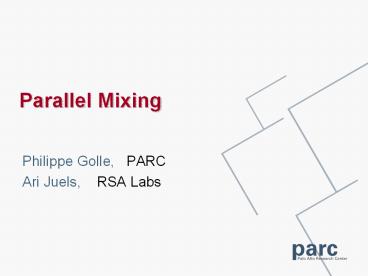Parallel Mixing - PowerPoint PPT Presentation
Title:
Parallel Mixing
Description:
Parallel Mixing Philippe Golle, PARC Ari Juels, RSA Labs – PowerPoint PPT presentation
Number of Views:71
Avg rating:3.0/5.0
Title: Parallel Mixing
1
Parallel Mixing
- Philippe Golle, PARC
- Ari Juels, RSA Labs
2
Anonymous Channel
Alice
Charlie
Bob
3
What are Anonymous Channels Useful for?
- They underlie most privacy applications
- Anonymous elections
- Anonymous email
- Anonymous payments
- Anonymous Web browsing
- Censorship resistant publication
4
Implementation Mix Network
Outputs
Inputs
5
Mix Network
Outputs
Inputs
?
?
?
One honest server guarantees privacy
6
A Look Under the Hood
- Sealing an envelope public key encryption
- Decryption key is shared among mix servers
- Opening an envelope joint decryption
- Requires cooperation of a quorum of servers
- Mixing envelopes re-encryption
- We use a randomized encryption scheme
- many (2160) different ways to encrypt a message
- Re-encryption create a new ciphertext that
decrypts to the same message - Message is unchanged
- Ciphertext is unrecognizable
- Re-encryption is a public key operation
7
Computational Cost
- Cost of mixing
- Dominated by re-encryption
- Re-encryption 2 modular exponentiations per
input - Assume n inputs and k servers
- Cost per server O(n)
- Assume sequential mixing
- Total mixing time is O(k.n)
- Can we decrease the total mixing time?
- Most of the mix servers are idle most of the time
- Idea parallelize the mixing!
k n Total time
3 10,000 8 min
3 100,000 70 min
8
Parallel Mixing (1st Try)
Round 3
Round 2
Round 1
Outputs
Inputs
Batch 1
Batch 3
Batch 1
Batch 2
Batch 1
Batch 2
Batch 3
Batch 3
Batch 2
9
Parallel Mixing (1st Try)
- Assume n inputs and k servers
- Divide inputs into k batches of size n/k
- Every server mixes every batch (in parallel)
- Computational cost
- Per server k. (n/k) n (as before)
- Total cost k. n kn (as before)
- Total mixing time k.(n/k) n (instead
of kn) - We cut the total mixing time by a factor of k
- But anonymity set is n/k instead of n
- Inputs are mixed within a batch
- There is no mixing between batches
10
Building Block Rotation
Round i1
Round i
Batch 1
Batch 1
Rotation Each server passes its batch on to
the next server in round robin fashion
Batch 2
Batch 2
Batch 3
Batch 3
11
Building Block Distribution
Round i1
Round i
Distribution Each server splits its batch and
gives one piece to every other server.
12
Parallel Mixing Protocol
- Parameters
- n inputs
- k mix servers
- Adversary controls at most k servers (e.g.
kk-1)
- k rounds of mixing rotation
- One distribution
- k rounds of mixing rotation
13
Example ( k5, k 3)
Rotation
Mixing
14
Example ( k5, k 3)
Mixing
15
Example ( k5, k 3)
Mixing
Rotation
Distribution
16
Parallel Mixing
- Protocol
- Divide inputs into k batches of size n/k
- k rounds of mixing and rotation (kltk)
- Distribution
- k rounds of mixing and rotation
- Computational cost
- Per server 2(k1)n/k 2n
- Total cost 2(k1)n 2kn
- Total mixing time 2(k1)n/k 2n
- Total mixing time divided by k2/2(k1) k/2
- Anonymity set of size n
- Cost per server is at most doubled
17
Anonymity Set
- Recall that the adversary A may
- Control up to k mix servers
- Submit up to a fraction a of the n inputs
- Let p0 be an input (not submitted by A). We
compute the probability - that input p0 became output p1, in the view of
A. - Ideally,
18
Anonymity Set
Outputs
Inputs
Distribution
p0
n/k
n/k
p1
Batch B0
Batch B1
19
Anonymity Set
- Adversary controls no input
- Adversary controls a fraction a of the inputs
(assuming uniform distribution)
20
Optimality
- Our construction has nearly optimal total mixing
time 2(k1)n/k - Proposition Let A be an adversary who controls
kltk servers. Any mixnet with anonymity gt1 with
respect to A must have total mixing time at least
(k1)n/k. - Proposition Let A be an adversary who controls
kk-1 servers. Any mixnet with anonymity gt1 with
respect to A must have total mixing time at least
2n.
21
Conclusion
- Our protocol reduces total mixing time from O(kn)
to O(n) - This is optimal within a factor of 2
- Open problem exact optimality?
- Questions?































